| |
 |
November 2015 |
 |
|
| |
| |
|
Welcome
Welcome to the November issue of the USAPEEC ASEAN Regional Office.
The newsletter seeks to provide readers with useful product and major market information for institutional and consumer users of U.S. poultry. Readers will find in every issue a variety of general market information, program activities as well as useful product information.
This month, we take a look at several market perspectives in the individual ASEAN countries.
Contents:
- Food & Hotel Malaysia Show casts a wide net and attracts growing number of exhibitors
- Trans-Pacific Partnership finally concluded
- Growing interest in procuring international food products in Cambodia
- Cambodia Culinary Competition displays the best of Cambodia’s culinary skills
- Is the hawker food heritage dying?
- All Things Eggs (Part 2)
- Farm-to-table Restaurants
|
|
|
| |
|
|
|
| |
|
Additional Market Information Available
We have updated our website to include more information on market reports and export documentation guidelines.
You can visit our ASEAN website at: www.usapeecasean.com |
|
|
| |
|
|
|
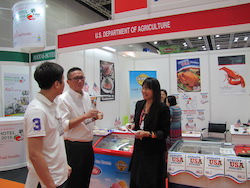 |
|
Food & Hotel Malaysia Show casts a wide net and attracts a growing number of exhibitors
The recent Food & Hotel Malaysia Show in Kuala Lumpur attracted a wide spectrum of exhibitors coming from diverse geographical regions.
Over 1,200 exhibitors from 50 countries participated in the four-day show from September 29 to October 2.
There were a total of eight national pavilions from China, Japan, Korea, Singapore, South Africa, Taiwan, Turkey and USA. Exhibitors participated from
Argentina, Australia, Brazil, Bulgaria, Chile, Colombia, India, Indonesia, Japan, New Zealand, Paraguay, the EU, Switzerland, South Africa, Saudi Arabia and UAE, South Korea, Thailand as well as the United States.
An estimated 19,000 trade visitors thronged the busy aisles to sample the various cuisines, packaged grocery products, baked goods and confectionery from all over the world.
USAPEEC ASEAN director, Margaret Say, who helped to man a table space at the USDA booth, received a sizeable number of inquiries on U.S. poultry. Significant numbers of trade contacts from various sectors of the food industry were obtained during the show days. |
|
Ag Attache Joani Dong meet with Malaysian importers at the Food & Hotel Malaysia Show |
| |
|
|
|
| |
|
Trans-Pacific Partnership finally concluded
The Trans-Pacific Partnership (TPP) was finally concluded in Atlanta on October 5, 2015 after seven lengthy years of arduous negotiations between the 12 participating countries in Asia Pacific. These countries include Australia, Brunei, Canada, Chile, Japan, Malaysia, Mexico, New Zealand, Peru, Singapore, the U.S. and Vietnam.
It will create the world’s largest free trade area representing US$30 trillion or 40 per cent of the world’s economy. The agreement will go beyond reducing tariffs on the flow of goods.
In addition, it will also cover agreements on services trade, labour, and environmental standards as well as non-tariff barriers. The trade pact will reduce tariffs on 18,000 goods including politically sensitive areas such as agriculture, autos and pharmaceuticals.
The TPP agreement is expected to boost regional trade and investments for participating countries though not uniformly. Vietnam and Malaysia which are heavily export-dependent are expected to benefit substantially from improved trade access as well as increased foreign direct investments. As a regional trade hub, Singapore is also anticipated to benefit significantly from participation in the trade bloc. |
|
| |
|
|
|
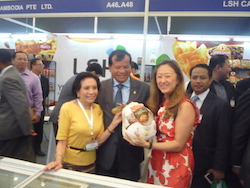 |
|
Growing interest in procuring international food products in Cambodia
The Siem Reap International F&B and Hospitality Show 2015 was recently held in Cambodia’s major tourist resort city of Siem Reap from October 6-8 2015. Siem Reap has most of the country’s four and five star hotels located within the city.
The show attracted participation from a wide range of international food companies from the U.S., EU, Australia, and from individual countries in the Asia Pacific region. Trade visitors which include importers, wholesalers, supermarkets, airline caterers, bakery and confectionery shops, catering services restaurants thronged the USAPEEC booth during the three-day show. Food tasting of cooked U.S. poultry products was carried out during the show. Numerous inquiries on sourcing U.S. poultry were received during the trade show days.
The show provided an opportunity for USAPEEC to expand the range of trade contacts among the various segments of the food service industry in Cambodia. |
|
Cambodian Minister for Tourism Dr. Thon Khon with U.S. Deputy Chief of Mission, Julie Chung(R) & Margaret Say(L) |
 |
Frontal View of USAPEEC Pavilion at Siem Reap Show |
 |
Margaret Say, USAPEEC ASEAN Director responding to trade inquiries |
| |
|
|
|
 |
|
Cambodia Culinary Competition displays the best of Cambodia’s culinary skills
In conjunction with the Siem Reap International F&B and Hospitality Show, the Cambodia Culinary Competition held during October 6-8 attracted the participation of a large number of local chefs. A wide range of culinary skills were displayed during the competition. USAPEEC was the platinum sponsor of the competition which had a special poultry cooking section. The Deputy Minister, Secretary of State, Ministry of Tourism Pak Sokhon was the guest-of-honor at the awards ceremony. |
|
Participants at Cambodia Culinary Competition |
| |
|
|
|
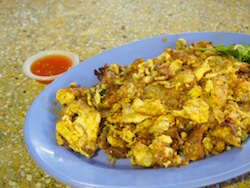 |
|
Is our hawker food heritage dying?
Hawker centres (or centralised food stalls) have been around in Singapore since 1971 as part of the government’s street hawkers resettlement program.
Hawker centres which offer multi-ethnic Singapore cooking at low meal prices at its best are located primarily in suburban residential housing estates. In recent years, the Singapore hawker heritage is facing pressing issues such as the dwindling numbers of hawkers as older hawkers retire with no infusion of replacements from the younger generation. With the mind-set that being a hawker is “uncool”, “tough” and generates low income, there are few people who aspire to be hawkers. The job requires being in an unending high-pressure service environment with a lower income return as compared to a cushy office job.
However, despite the long hours and hot environment, there are indeed young hawkers who willingly took up the job. Several notable exceptions include Coffee Break, Fishball Story and A Noodle Story.
Located at Amoy Street Food Centre, Coffee Break is helmed by two siblings, who took over their family’s coffee stall founded by their grandfather in 1935. Offering not only traditional coffee, but latte, mocha in assorted flavours such as caramel, hazelnut, sea salt mint, Coffee Break is like a mini Starbucks but in a traditional setting. Their blends are all brewed with the sock. Situated at a strategic location with plenty of caffeine-dependent workers, they stand out for their combination of traditional and modern coffee choices.
Apart from Coffee Break, there are other young hawkers who continue to work for the preservation and promotion of the hawker centre. A Noodle Story, helmed by two SHATEC graduates, fuses both traditional recipes and new influences and flavours to create Singapore-style ramen to suit local taste buds.
To combat the problem of a vanishing hawker trade, the Workforce Development Agency (WDA) is collaborating with the National Environment Agency (NEA) to introduce a new hawker training scheme that will see up to 50 aspiring hawker entrepreneurs honing their skills from veteran hawkers in the trade over a 5-6 month period.
Besides help from the government, some social enterprises such as Shiok Collective, Hawker Initiative and Project Dignity have sprouted in April 2013 to help train and empower disadvantaged individuals to be hawker-preneurs.
A counter-part with a similar mission, Project Dignity is Singapore’s first full-fledged hawker training and food court management school which aim to educate and to advance the interest in the hawker trade. They offer programmes of Singapore Workforce Skills Qualification (WSQ) standards, which are conducted in a functional food court. Hopefully with the above initiatives, the hawker food heritage will continue to thrive. |
|
Oyster Omelette |
| |
|
|
|
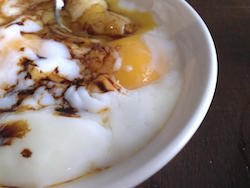 |
|
All Things Eggs (Part 2)
In our previous article on eggs, we discussed about the product being used in baking. Although eggs are one of the most commonly used foods in the kitchen, they are useful for more than just baking and cooking.
Coffee and eggs
In Singapore, mixing hot Milo (local malt beverage) with a raw egg (known as Milo ka koi neng in Hokkien) is an obscure but interesting drink that people order in coffee shops. Milo ka koi neng acts as an energy drink for people who are very tired and needed a pick-me-up for the tough day ahead. It is recommended to stir this combination quickly so there would not be any streaks of cooked egg floating in the beverage.
Another unique concoction found in Singapore is the combination of Guinness Foreign Extra Stout with raw eggs. The blend of stout and raw egg is supposedly used to boost male virility. Apart from Singapore, the tradition of mixing stout with raw eggs is known in the cultures in Africa, and the Caribbean.
In Sweden and Norway, the Scandinavian egg coffee is a traditional brewing method which has spread to parts of the American Midwest. The technique calls for a whole raw egg to be mixed with the coffee grounds before adding them to boiling water and then strained. As a paper filter is not used to make this coffee, the essential oils of the beans are left in the drink. Some coffee drinkers also add egg shells into the drink, as the calcium carbonate in the shell neutralizes the acid extracted from the coffee. The result is a rich, drinkable coffee that has little to no bitterness or acidity.
The Vietnamese egg coffee is yet another beverage with a long history. An egg coffee in Vietnam is traditionally prepared with egg yolks, sugar, condensed milk and coffee. The egg cream is made by beating egg yolks with condensed milk until a frothy, fluffy mixture. Fill half a cup with brewed coffee and pour a similar amount of egg cream on top.
Eggs on the face isn’t a bad thing
Eggs are not only good for your stomach, but great for your face as well. Egg white is great as a beauty supplement. It works wonders for greasy skin by shrinking large pores on the skin surface, reducing excess sebum. Large pores are also potential breeding grounds for bacteria that cause zits and cysts, which mean pore-tightening egg white can help reduce acne.
Egg white has been used in face mask recipes since ancient times, especially in Asia, to achieve beautiful radiant skin. You can make a mask with egg white alone, or you can add in other ingredients to provide more nourishing benefits to your skin.
Do not discard the egg yolk after making your egg white facial mask though. Since the 1940s or earlier, women have made egg hair treatment mixes as well as selected shampoos that contain eggs. In fact, an egg yolk hair mask can be one of the most effective hair treatments. The yolk is especially helpful for dry, damaged hair and when used alone or with other ingredients, the treatment will give you shiny, strong, and healthy hair.
Try out some of the egg coffees or DIY facial or hair masks the next time you have some time on your hands. You may be pleasantly surprised at how eggs enhance your coffee or even aid in your beauty regime. |
|
Soft-boiled eggs
Credits: Pauleon Tan |
| |
|
|
|
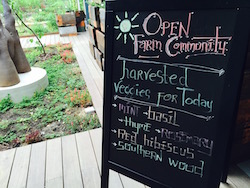 |
|
Farm-to-table Restaurants
As the world is progressing towards a sustainable environment, it is no wonder that the food industry is aligned to the same goal as well. The farm-to-table movement is built on the idea that food is best when fresh and it encourages people to swap processed, modified foods for local, natural and unaltered produce, dairy and meats.
In today’s hectic and technology-driven world, the movement brings us back to the basics and encourages us to enjoy fresh and simple foods. More of today’s consumers understand the value of eating local, seasonal food, and are willing to pay a premium to get it.
The farm-to-table movement is not just a fad in the West; it has moved to Southeast Asia. The movement thrives as concerns over sustainable and ethical eating spread. Slowly but surely, it arrived in Thailand in the form of special dinners and menus. Restaurant owners and chefs are starting to grow their own produce, or making a concerted effort to use local products, and the farm owners that supply them. To the chefs, it is about the ethics, freshness and the promise of sourcing the best for the customers which lead them to source for local products or farms. At the same time, it is a win-win situation for both the farmers and restaurant chefs as the farmer gets a guaranteed income while the restaurant gets fresh and nutritious products.
Farm to Table Organic Café in Bangkok not only grows their vegetables, but they also take it one step further by making ice cream from their own produce – pumpkin, potatoes, carrots, strawberry that are guaranteed by the International Foundation for Organic Agriculture. In Chiang Mai, Café Mini uses produce from The Royal Project, a foundation set up by the Royal Family that supports the development of small farms. Café Mini’s future plans include creating their own hydroponic salad garden.
In Singapore, local restaurants such as Artichoke and Morsels have been in partnership with Edible Gardens, an urban farming consultancy which advocates the “Grow your own food” movement. Artichoke has its own herb and vegetable garden which comprises of 17 species. The garden enables the restaurant to be self-sufficient in herbs like basil, mint and borage. Leaves and branches from the plants are used for smoking meats, and the ashes are used to fertilise the garden. At least 30% of the dishes on Artichoke’s regular a la carte menu feature ingredients farmed in Singapore.
Sitting on 35,000 square feet of green land, Open Farm Community (OFC) is also partnering with Edible Garden for food production. Besides palatable food and drinks from their restaurant and café, OFC also offer a variety of activities such as table tennis, lawn bowl, sand playground, or have a quaint walk through their garden. To further educate the public on urban farming, OFC is starting their New Urban Farmers’ Project, a community farming initiative which aims to equip participants with the skills to grow their own food.
With more people turning their spaces into urban farms, creating a vibrant and sustainable living environment for future generations does not seem so far-fetched after all.
|
|
Open Farm Community using homegrown harvest for their meals. |
|
Disclaimer: All opinions and views expressed in the articles published in the newsletter are those of the individual journalists and do not necessarily reflect those of the publisher, the newsletter's sponsors or USA Poultry & Egg Export Council.
You have received this email because you have registered to get newsletters from USAPEEC ASEAN.
If you prefer not to receive these updates, please
click here
to unsubscribe.
Do not reply to this email. For enquiries, go to www.usapeecasean.com
® USA POULTRY & EGG EXPORT COUNCIL
541 Orchard Road, #15-04, Liat Towers, Singapore 238881 Tel: (65) 67371726 Fax: (65) 67371727
*|REWARDS|* |
|
|
|